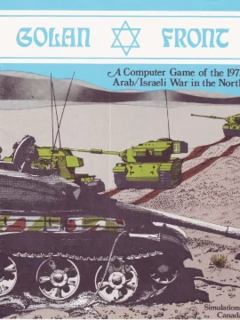 W
WThe Yom Kippur War, Ramadan War, or October War, also known as the 1973 Arab–Israeli War, was fought from October 6 to 25, 1973, by a coalition of Arab states led by Egypt and Syria against Israel. The war took place mostly in Sinai and the Golan—occupied by Israel during the 1967 Six-Day War—with some fighting in African Egypt and northern Israel. Egypt's initial war objective was to use its military to seize a foothold on the east bank of the Suez Canal and use this to negotiate the return of the rest of Sinai.
 W
WThe Al Jahra Force was a Kuwait task force, of roughly brigade strength, requested by then, Kuwait Minister of Defense, Sheikh Saad Al-Salim Al-Sabah and formed by Major General Mubarak Abdullah Al-Jaber Al-Sabah and his deputy Brigadier General Saleh Mohammed Al-Sabah; subsequently being tasked to the respective combat commanders on October 15, 1973, after the outbreak of the Yom Kippur War. The force, consisting of more than 3,000 men, was organized into a Tank Battalion, an infantry battalion, two companies of artillery, an anti-aircraft company and a combat company of the Kuwait 25th Commando Brigade. In addition, the task force also included medical, engineering and signal units. The brigade remained active until the end of September 1974, and then returned to Kuwait after a farewell ceremony in Damascus.
 W
WThe Bar Lev Line was a chain of fortifications built by Israel along the eastern bank of the Suez Canal after it occupied the Sinai Peninsula from Egypt during the 1967 Six-Day War. It was considered impregnable and was a symbol of Israeli military perfection. It was overrun in 1973 by the Egyptian military during Operation Badr.
 W
WThe Bashan Salient was a territory in Southwestern Syria which was conquered by the Israeli Army during the 1973 Yom Kippur War. The salient was about twenty kilometres wide and encompassed an area of approximately 400km2, extending to a point 33 kilometres from the Syrian capital of Damascus. The Salient was evacuated by the Israeli army shortly after the signing of a disengagement agreement between the Israeli and Syrian forces on May 31, 1974. The Salient included the summit of Mount Hermon, the town of Beit Jinn, and many other Syrian villages.
 W
WGolan Front is a 1985 video game published by Simulations Canada.
 W
WKippur (כיפור) is a 2000 Israeli drama war film directed by Amos Gitai. The storyline was conceived from a screenplay written by Gitai and Marie-Jose Sanselme; based on Gitai's own experiences as a member of a helicopter rescue crew during the 1973 Yom Kippur War. The film stars actors Liron Levo, Tomer Russo and Uri Klauzner in principal roles.
 W
WThe Mitla Pass is a 480-metre-high (1,570 ft) pass snaking 32 kilometres (20 mi) in the Sinai Peninsula of Egypt, wedged between mountain ranges to the north and south. It is located about 50 kilometres (31 mi) east of Suez. It is the monotonous ride through here and Nekhel, a wilderness that provides the shortest route between Nuweiba and Cairo. Buses carrying tourist to Mount Sinai, St. Catherine's Monastery, and Feiran Oasis travel through here.
 W
WOperation Abirey-Halev or Operation Abirey-lev, also known as Operation Stouthearted Men, code-named Operation Gazelle, is an Israeli operation that took place in the center of Suez Canal on 15–23 October 1973 during the Yom Kippur War.
 W
WOperation Nickel Grass was a strategic airlift operation conducted by the United States to deliver weapons and supplies to Israel during the 1973 Yom Kippur War. In a series of events that took place over 32 days, the U.S. Air Force's Military Airlift Command shipped 22,325 tons of tanks, artillery, ammunition, and supplies in C-141 Starlifter and C-5 Galaxy transport aircraft between 14 October and 14 November 1973. The U.S. support helped ensure that Israel survived a coordinated and surprise attack from the Soviet-backed Arab Republic of Egypt and Syrian Arab Republic.
 W
WThe United Nations Disengagement Observer Force (UNDOF) was established by United Nations Security Council Resolution 350 on 31 May 1974, to implement Resolution 338 (1973) which called for an immediate ceasefire and implementation of United Nations Security Council Resolution 242.
 W
WThe three-line United Nations Security Council Resolution 338, adopted on October 22, 1973, called for a ceasefire in the Yom Kippur War in accordance with a joint proposal by the United States and the Soviet Union. The resolution stipulated a cease fire to take effect within 12 hours of the adoption of the resolution. The "appropriate auspices" was interpreted to mean American or Soviet rather than UN auspices. This third clause helped to establish the framework for the Geneva Conference (1973) held in December 1973.
 W
WUnited Nations Security Council Resolution 368, adopted on April 17, 1975, recalled previous resolutions and considered a report from the Secretary-General before calling upon the parties involved in the prevailing state of tension in the aftermath of the Yom Kippur War to immediately implement resolution 338. The Council then renewed the mandate of the United Nations Emergency Force for another three months until July 24, 1975, and requested the Secretary-General submit a report on the developments in the situation and the measures taken to implement the resolution.
 W
WUnited Nations Security Council Resolution 369, adopted on May 28, 1975, expressed concern over the prevailing state of tensions between Israel and Syria and reaffirmed that the two previous agreements on disengagements of forces were only a step towards the implementation of resolution 338. The resolution then decided to call upon the parties concerned to immediately implement resolution 338, renewed the mandate of the United Nations Disengagement Observer Force for another 6 months and requested the Secretary-General submit a report on the situation at the end of those 6 months.
 W
WUnited Nations Security Council Resolution 378, adopted on October 23, 1975, considered a report by the Secretary General and noted the developments in the situation in the Middle East. The Secretary General viewed any relaxation in the search for peace at that time to be especially dangerous and urged for a resolution to the situation, namely through the adaption of the plan laid out in resolution 338.
 W
WValley of Tears, is an Israeli war series directed by Yaron Zilberman based on a screenplay by Ron Leshem and starring Aviv Alush, Joy Rieger and Lior Ashkenazi. The production of the series lasted about a decade and its filming took place over 52 days starting on July 21, 2019. The premiere episode of the first season aired on Kan 11 on October 19, 2020. It was subsequently licensed by HBO Max, airing on November 12, 2020.
 W
WYuri Olefirenko is a mid-size landing ship of the Ukrainian Navy of Project 773. From its original commissioning in 1971 and until the 2014 Crimean reunification with Russia, she was based in the Southern Naval Base at Donuzlav. Since then Yuri Olefirenko was relocated to Ochakiv.
 W
W